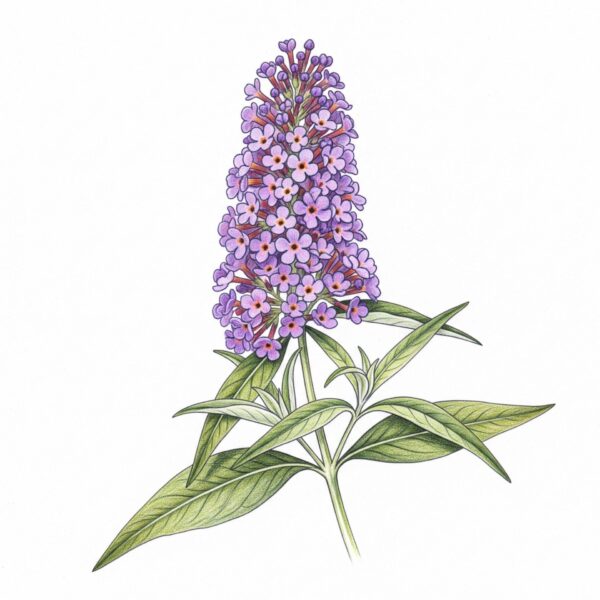Key Characteristics::
- Appearance: Butterfly bush is a large shrub that typically grows to a height of 6-12 feet (2-4 meters) with a spread of 4-8 feet (1-2.5 meters), though some cultivars are smaller. It has an arching, bushy habit. The leaves are lance-shaped, green or gray-green on top, and covered with fine, downy hairs on the underside, giving them a whitish appearance.
- Flowers: The most striking feature of the butterfly bush is its flowers. From summer into autumn, it produces dense, cone-shaped flower spikes, known as panicles, that can be up to 18 inches (46 cm) long. The individual flowers are small, tubular, and have a strong honey-like fragrance. While the wild species has lilac to purple flowers with an orange throat, numerous cultivars are available in a wide range of colours, including white, pink, red, and various shades of purple.
- Pollinator Attraction: As its common name suggests, the plant is a superb source of nectar, making it incredibly attractive to butterflies, bees, and other beneficial insects.
- Growth and Hardiness: Buddleja davidii is a very vigorous and hardy plant. It is tolerant of a wide range of conditions, including drought, heat, and poor soil, as long as the soil is well-drained. It thrives in full sun, requiring at least 6-8 hours of direct sunlight per day to produce the best blooms. In colder climates, the plant die back to the ground in winter, but it will regrow quickly in the spring.
Care and Maintenance::
- Pruning: A key aspect of caring for butterfly bush is annual pruning. It blooms on new wood, so a hard prune in early spring (just as new growth emerges) is recommended. This encourages vigorous new growth, which leads to more profuse flowering and helps maintain a good shape.
- Deadheading: Promptly removing the spent flower spikes (deadheading) throughout the blooming season will encourage the plant to produce more flowers and prevent it from self-seeding. This is particularly important because Buddleja davidii can be invasive in some regions.
- Soil and Water: Plant in well-drained soil; the plant does not tolerate soggy conditions, especially in winter. While it is drought-tolerant once established, providing medium moisture can improve flowering.
- Fertilizing: Butterfly bush does not require heavy fertilization. An annual application of compost or a general-purpose, high-potash feed in the spring is usually sufficient.
Invasive Potential:
While a beloved garden plant, Buddleja davidii is considered an invasive species in some areas, particularly in the UK and parts of the United States. Its ability to produce millions of wind-dispersed seeds allows it to colonise disturbed areas like railway banks and waste ground, where it can outcompete native plants. To mitigate this, removing spent flowers before they set seed is highly recommended, and sterile cultivars are now available.

